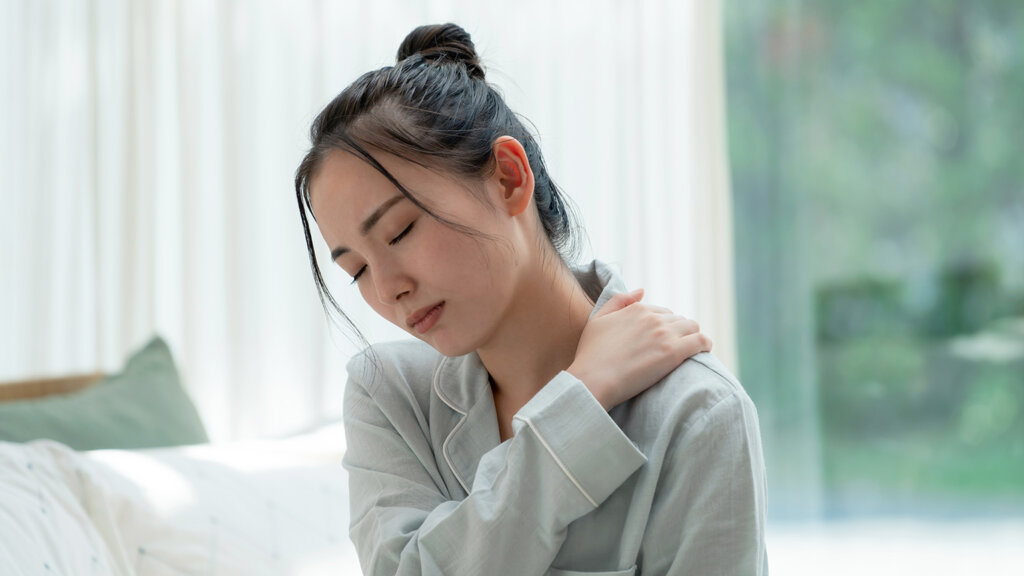Physical Anxiety Symptoms Without Feeling Anxious: Understanding Your Body’s Response
 Key Takeaways
Key Takeaways
-
Anxiety doesn’t only manifest as emotional distress.
-
Our bodies might show signs of Anxiety, like irregular heartbeats or shortness of breath, even if we don’t recognize any anxious feelings mentally.
-
Some common physical symptoms include somatic symptoms, autonomic arousal (like sweating or trembling), hypervigilance, over-reactivity, frequent bathroom visits, restlessness, and tingling sensations in hands and feet.

Anxiety isn’t just about how we feel emotionally. It’s a comprehensive response that can affect our bodies in ways we might not readily associate with feeling anxious. In many instances, people experience physical symptoms of Anxiety without attributing them to state of their Mental Health. It’s crucial we learn how to identify the physical responses to mental or emotional stimuli so that we can find ways to soothe our Anxiety and become the best version of ourselves.
Many people ask, “What does anxiety feel like physically?” The answers might surprise you.
Which Types of Anxiety Cause Physical Symptoms?
Anxiety is a natural and occasional response to life’s challenges. For some, however, Anxiety can become persistent, affecting daily life. Anxiety isn’t just an emotional experience; it often presents with physical symptoms, which can occur even when one isn’t feeling overtly anxious.
Understanding the root cause of your Anxiety can provide clarity. Additionally, identifying specific types of Anxiety we experience can shed light on the physical symptoms we feel in the moment, getting us closer to a resolution that feels good. Various Anxiety Disorders might be culprits for physical symptoms:
Generalized Anxiety Disorder (GAD), a pervasive feeling of worry about everyday events, is perhaps the most common type of Anxiety. This can be intense and hard to control, leading to physical reactions. These physical reactions are numerous but include things like stomach aches, dizziness, shortness of breath, dry mouth, and many others.
Another type of Anxiety is Post-Traumatic Stress Disorder (PTSD). Stemming from traumatic events, PTSD can trigger physical reactions when reminded of the trauma. Some of these include loss of sleep, ringing in the ears, weight gain, or indigestion, among others.
A fairly common condition is Social Anxiety Disorder. Here, the fear of social situations can manifest physically when in or anticipating scenarios such as parties, performances, work meetings, and more. You might feel dizzy or nauseous or experience increased sweating or stomach issues.
Obsessive-Compulsive Disorder (OCD) is also one of the many types of Anxiety that has physical symptoms. Compulsions and obsessions can lead to physical manifestations, especially if rituals are not completed. The physical symptoms of OCD are vast, but the most common are feeling like one’s skin is crawling, obsessive itching, nausea, and many more.
Lastly, Panic Disorder has some of the most intense physical attributes. If left untreated, this can greatly impact the quality of life and manifest in physical symptoms such as chills, sweating, chest pain, and more.
Is It Possible to Feel Physical Anxiety Symptoms Without Feeling Anxious?
Short answer: Yes.
Long answer: Our bodies are complex systems. Anxiety might manifest as physical sensations, like an irregular heartbeat or shortness of breath, even when we don’t identify a particular anxious thought or feeling. The brain and body are interconnected, and sometimes, the body reacts even when our conscious mind isn’t aware of any distress. In addition to the short-term physical symptoms, those with Anxiety Disorders may also experience long-term physical ailments such as digestive issues.
LifeStance Health is a national leader in mental, behavioral, and emotional wellness with multiple locations in 33 states. Services vary by location.
Find a provider near you:
- Arizona
- California
- Colorado
- Delaware
- Florida
- Georgia
- Illinois
- Indiana
- Kansas
- Kentucky
- Maine
- Maryland
- Massachusetts
- Michigan
- Minnesota
- Missouri
- Nevada
- New Hampshire
- New Jersey
- New York
- North Carolina
- Ohio
- Oklahoma
- Oregon
- Pennsylvania
- Rhode Island
- South Carolina
- Tennessee
- Texas
- Utah
- Virginia
- Washington
- Wisconsin
Feelings That May Be Signs of Anxiety
While Anxiety may feel different to each individual, there are some common manifestations of the condition.
- One characteristic is experiencing somatic symptoms or physical sensations related to Anxiety. Somatic symptoms include physical sensations such as headaches, stomach aches, muscle tension or pain, fatigue, heart palpitations, shortness of breath, dizziness, numbness or tingling, and skin issues. These might arise during a particularly stressful or Anxiety-inducing situation or later on after an event has occurred.
- Some people also experience autonomic arousal, such as sweating or trembling. This can be as uneventful as sweaty hands before a big presentation or as serious as constant trembling of the hands.
- Hypervigilance, or a heightened state of sensory sensitivity, is also common.
- Over-reactivity may also occur and is characterized by exaggerated reactions to stimuli.
- Frequent trips to the bathroom are also associated with Anxiety.
- Restlessness is also common, and those with Anxiety might feel the discomfort of not being able to fully relax.
- Tingling sensations in the hands and feet may also arise.

What Should You Do When You Notice Physical Symptoms of Anxiety?
Recognizing these symptoms is the first step. There are many strategies to combating physical symptoms of anxiety. The most turnkey strategy is breathwork. Taking deep, controlled breaths can help calm the body’s physiological response. Practicing mindfulness and meditation can also help you feel grounded in the present moment, reducing feelings of stress and anxiety. Remember that if certain situations heighten your symptoms, it might be beneficial to avoid or approach them differently.
When physical symptoms of Anxiety arise, staying connected to those around you can help tremendously. Talk to someone you trust about your symptoms, or seek the support of expert providers who can offer coping strategies or treatments. At LifeStance, our dedicated team specializes in Anxiety Disorder treatment. We’re here to help.
For a more in-depth understanding and personalized assistance, visit LifeStance’s Anxiety Disorder Treatment page.
Reviewed By

Nicholette is a faculty member at John Carroll University’s Clinical Counseling program, and she is also the host of the LifeStance podcast, Convos from the Couch.

